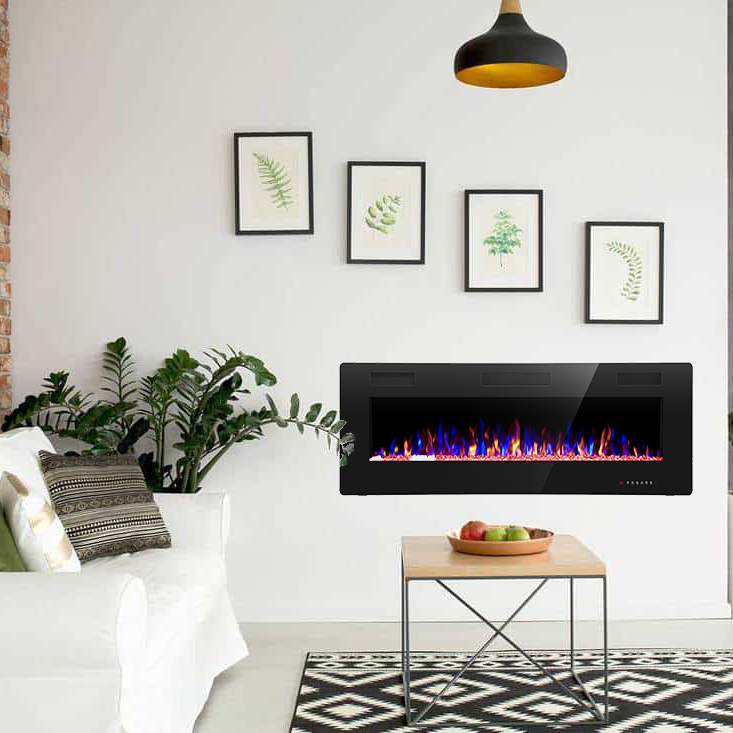As the winter get colder, so do we; and we need a heating appliance. Imagine studying at your dorm, working in your office, or even trying to sleep while staying warm and toasty. Now, that is convenient. With an electric fireplace, you can carry on with your daily activities without getting disturbed by cold temperatures.
Unlike traditional wood stoves, which require a constant supply of heat and a large amount of labor, electric fireplaces use an electric heater in place of a real fire to provide heat and also give you the effect of light and fire.
Since electric fireplaces are powered by electricity, one of the most common issues that arise is how much they can affect your electricity bill. Don’t worry, we will let you know here.

What is the Electricity Consumption of these electric fireplaces?
To figure out the consumption of an electric fireplace, we need to know some basic knowledge.
The power consumption is measured mostly in BTUs (Which can be measured in Watts (W) and Amperages (A) too).
It is instrumental in determining the energy output of a space heater since some heaters have multiple or different power levels, as well as unique heat settings.
BTUs are capable of ascertaining the heating capacity of not only electric-based space heaters such as ceramic heaters. Still, they can also calculate the thermal energy output of heaters that use fuel such as kerosene, paraffin, or gas heaters.
Additionally, it can also determine the capacity of cooling systems.
Heater Wattage Rating (W) x 3.413 = BTU Output
3.413 is the amount of BTU that is equal to 1 Watts of energy, and therefore a standard in this circumstance.
Thus, a heater with a 1,500 Wheater wattage rating would be 1,500 W x 3.413 = 5119.5 BTU.
This means that a 1,500 W space heater is capable of delivering 5119.5 BTU of heat, and a lower setting of 500 W will provide approximately 1,700 BTU of heat.
Thus, a heater with a higher BTU rating would generally have greater power consumption.

How much does it cost to run an electric fireplace?
The cost of running an electric fireplace depends on three main factors: power consumption of the unit itself, operating time, and the cost of electricity in your area.
Using the general max specifications of these Electric Fireplaces (120 volts, 1,500 watts), we can provide a reasonable estimate of the cost to operate an electric fireplace.
Energy rates vary depending on where you live. The U.S. Energy Information Administration (EIA) tracks electricity prices by state. The most recent reports from the EIA show the average residential electricity rate in the U.S. is 15.95 cents per kilowatt-hour (kWh). (Updated November 2, 2022)
This means it will cost you approximately 23.9 cents per hour to run an electric fireplace.
If you use it just for ambiance, then the cost can range anywhere from $0.005 to $0.05 per hour.
However, if you use a heating unit as well, the costs will go up to around $0.09 per hour for a medium setting and $0.18 per hour for the maximum setting.
The average cost per year for this may be around $80. This assumes that you’re not going to use it throughout the year or every season of the year.
Most people use electric fireplaces around the winter season, especially during popular holidays such as Thanksgiving, Christmas, and New Year’s Eve. By most estimates, using electrical fireplaces can reduce the energy consumption of an average household by nearly 20%.
Which is the Best for You?
Comparing these electric fireplaces and deciding on only one for your home can be a bit of a challenge. Since they all have their own pros and cons, there's no single answer for every homeowner.
1.R.W.FLAME 25" Electric Fireplace StoveFor example, if you want the most economical heating appliance, then this electric fireplace stove must be your first choice. It is quite small and compact, and the lower heating mode of it requires just 500 watts of electricity and can deliver warmth to your personal space. Because it is quite portable, this heater can be easily moved around.
Because of its low wattage, you can be sure that your heater doesn’t eat too much into your electricity bills and is unlikely to damage your circuit. It is a very cost-effective option compared to other ways of staying warm.
2.R.W.FLAME 60'' Recessed Electric Fireplace

If you love the atmosphere of different flames, a Recessed Electric Fireplace is the right choice. This heater features two heat settings allowing you to switch between 750 to 1500 watts to help further save energy while warming up your personal space. It uses LED technology which offers multicolor flame with a realistic fire effect and flickering flame. With 12 flame & LED flame bed color modes, 5 flame speed modes, and 5 flame brightness levels, the flame could automatically change the flame color and brightness. This eye-catching automatic flame design makes it so authentic that just like a real fire.
By controlling it to produce different types of flame patterns, you could get a customized experience every single time! Also, the soft flickering lights provide a source of light during cold nights as well as a relaxing atmosphere.
3.R.W.FLAME 43"Wooden Mantel Electric Fireplace
On the other hand, if you're longing for the classic appearance of a traditional wood-burning fireplace, an Wooden Mantel Electric Fireplace is the right choice. It can be a great focal point for any room in your home, creating a pleasant atmosphere of home peace that you want others to feel when they come into your home.
For most homeowners, the decision is not so simple, so it pays to understand the differences between these types of fireplaces.





1 comment
Maria THERESA
Excellent information.
I have a better understanding of the different fire places and cost to operate one. I enjoyed
The information provided.